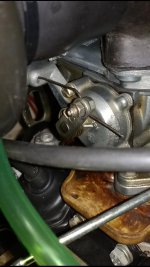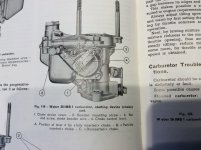Your engine sounds fine in the short video, except tickover speed is a bit low especially with the choke in operation. Maybe try raising idle speed a little?
If your engine was running too rich, it would probably start in cold weather without choke and in fact would likely sound stifled if you used the choke with a tendency to cut out and be difficult to restart, possible having wet the spark plugs with fuel.
If this happens, referred to as 'flooding the engine', don't use any choke, press and hold the accelerator pedal to the floor, and turn the engine over until it starts. Don't pump the pedal. Holding the pedal down, reduces the depression (vacuum) in the carb, limiting the amount of fuel being drawn in, so that the engine can start on the excess fuel already in the engine. Alternatively, if you leave it 15-20 mins the engine may start as excess fuel evaporates and plugs dry out or else remove and dry the plug tips and the car should start normally.
When an engine is running rich, it has a rythmical throbby/lumpy sound and doesn't sound 'happy'.
If very rich it will puff black smoke out the exhaust. It will also sound lumpy, smell bad and will tend to spit moisture onto your hand if you place it behind the exhaust pipe.
Be careful about 'reading' spark plug colour. If an engine is subjected to a number of cold starts using the choke and not given a decent run, the spark plugs may look 'sooty', then be interpreted as an engine that has a problem i.e. 'running rich', and result in the owner chasing after a non-existent problem with the accompanying risk of upsetting or damaging something.
This is why I deliberately didn't mention shaking the carb. float, the possibility of a pinhole in the float or adjusting the float level - I've seen too many floats damaged/dropped/accidentally squashed (I did say they were delicate), or their lever arm (controlling maximum and minimum travel) messed up/twisted/distorted by someone 'adjusting the float level'. Sometimes this is also followed by this question- "I tried to remove the float, the hinge pin wouldn't move, so I drove it out and then this bit of casting just fell away (i.e. broke off). Can I 'glue' it back on?
By all means check the float condition and level as others have suggested if you're sure you have a problem. If it's just a pinhole, dry out the fuel inside by leaving the float somewhere warm, then seal the hole with a tiny dab of epoxy resin or similar. I'd advise against solder, it's a bit tricky and can go wrong.
If your engine cuts out, be careful not to confuse a possible ignition problem with a carb./fuel problem - If it cuts out suddenly, think ignition - if it stumbles/runs roughly then cuts out, think carb/fuel.
If it was my car I'd take it for a several mile drive and then see how it runs and idles. Don't expect perfection with a classic car...
AL.
If your engine was running too rich, it would probably start in cold weather without choke and in fact would likely sound stifled if you used the choke with a tendency to cut out and be difficult to restart, possible having wet the spark plugs with fuel.
If this happens, referred to as 'flooding the engine', don't use any choke, press and hold the accelerator pedal to the floor, and turn the engine over until it starts. Don't pump the pedal. Holding the pedal down, reduces the depression (vacuum) in the carb, limiting the amount of fuel being drawn in, so that the engine can start on the excess fuel already in the engine. Alternatively, if you leave it 15-20 mins the engine may start as excess fuel evaporates and plugs dry out or else remove and dry the plug tips and the car should start normally.
When an engine is running rich, it has a rythmical throbby/lumpy sound and doesn't sound 'happy'.
If very rich it will puff black smoke out the exhaust. It will also sound lumpy, smell bad and will tend to spit moisture onto your hand if you place it behind the exhaust pipe.
Be careful about 'reading' spark plug colour. If an engine is subjected to a number of cold starts using the choke and not given a decent run, the spark plugs may look 'sooty', then be interpreted as an engine that has a problem i.e. 'running rich', and result in the owner chasing after a non-existent problem with the accompanying risk of upsetting or damaging something.
This is why I deliberately didn't mention shaking the carb. float, the possibility of a pinhole in the float or adjusting the float level - I've seen too many floats damaged/dropped/accidentally squashed (I did say they were delicate), or their lever arm (controlling maximum and minimum travel) messed up/twisted/distorted by someone 'adjusting the float level'. Sometimes this is also followed by this question- "I tried to remove the float, the hinge pin wouldn't move, so I drove it out and then this bit of casting just fell away (i.e. broke off). Can I 'glue' it back on?
By all means check the float condition and level as others have suggested if you're sure you have a problem. If it's just a pinhole, dry out the fuel inside by leaving the float somewhere warm, then seal the hole with a tiny dab of epoxy resin or similar. I'd advise against solder, it's a bit tricky and can go wrong.
If your engine cuts out, be careful not to confuse a possible ignition problem with a carb./fuel problem - If it cuts out suddenly, think ignition - if it stumbles/runs roughly then cuts out, think carb/fuel.
If it was my car I'd take it for a several mile drive and then see how it runs and idles. Don't expect perfection with a classic car...
AL.
Last edited:



